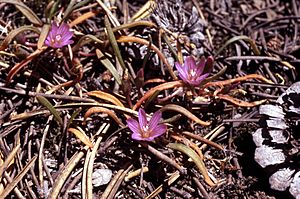Alpine lewisia facts for kids
Quick facts for kids Alpine lewisia |
|
|---|---|
 |
|
| Scientific classification | |
| Genus: |
Lewisia
|
| Species: |
pygmaea
|
The Lewisia pygmaea, also known as the alpine lewisia or pygmy bitterroot, is a small flowering plant. It belongs to the Montiaceae plant family. This plant is found naturally across western North America. You can find it from Alaska and Alberta all the way down to California and New Mexico.
It loves to grow in damp, rocky mountain areas. This includes places like gravel beds and sandy meadows. The alpine lewisia is a very diverse plant. It can look quite different depending on where it grows. It also often mixes its genes with other Lewisia plants. This can make it tricky to identify!
Contents
What Does Alpine Lewisia Look Like?
The alpine lewisia is a small plant that lives for many years. It grows from a thick main root called a taproot. It also has a short, woody stem base called a caudex.
Leaves of the Pygmy Bitterroot
- The plant forms a circle of leaves at its base, like a rosette.
- These leaves are usually 2 to 8 centimeters long.
- They are narrow but feel thick and fleshy.
- The tips of the leaves are blunt.
- Their shape can be long and thin (linear) or wider at the base and tapering to a point (lance-shaped).
Flowers of the Alpine Lewisia
- The flowers usually grow on very short stems.
- These stems often look like they are sitting right on top of the leaf rosette.
- Each flower has 5 to 9 petals.
- The petals can be white, pink, or red.
- Sometimes, they have dark lines or stripes.
- The petals are small, ranging from 4 millimeters to 1 centimeter long.
Where Does Alpine Lewisia Grow?
This plant is native to a large part of western North America. It thrives in mountain environments.
Regions Where It Is Found
- Alaska
- Alberta (Canada)
- British Columbia (Canada)
- California
- New Mexico
- Northwestern United States
Mountain Ranges and Habitats
- Cascade Range
- Great Basin
- Klamath Mountains
- Rocky Mountains
- Sierra Nevada (United States)
- Transverse Ranges
It prefers moist, rocky places. This includes gravelly areas and meadows with sandy soil.
See Also

